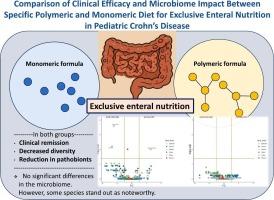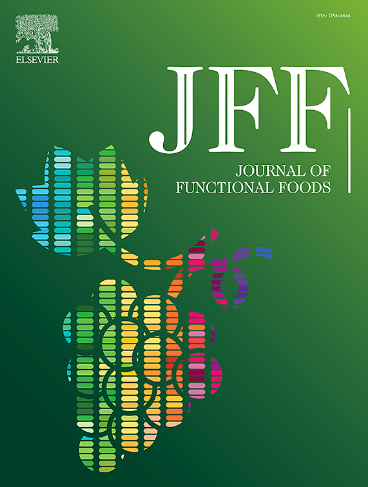Comparison of clinical effectiveness and microbiome impact between specific polymeric and monomeric diet for exclusive enteral nutrition in pediatric Crohn's disease: a prospective cohort study
IF 4
2区 农林科学
Q2 FOOD SCIENCE & TECHNOLOGY
引用次数: 0
Abstract
Background
According to the ECCO-ESPGHN guideline for the treatment of newly diagnosed pediatric Crohn's disease (CD), exclusive enteral nutrition (EEN) treatment is recommended for inducing remission. This study aimed to compare the clinical effectiveness and changes in the microbiome between the monomeric diet and a specific polymeric diet.
Methods
This prospective study included 38 healthy children and 48 pediatric patients with moderate to severe CD. The patients divided into two groups according to the type of EEN: monomeric diet (group A, n = 24) and polymeric diet (group B, n = 24).
Results
All patients achieved clinical remission. Baseline alpha diversity was lower in CD patients than in healthy controls (p < 0.001). Shannon diversity was statistically associated with ESR (p = 0.037). Faecalibacterium, Streptococcus sanguinis group, Enterococcus had decreased after EEN treatment (p = 0.003, p = 0.003, p = 0.026, respectively). There were differences in bacterial taxa between the two groups before starting EEN, but these differences disappeared after EEN. Bacteroides acidifaciens group and Butyricicoccus faecihominis group were associated with CRP (p = 0.016, p = 0.027, respectively) and ESR (p = 0.004, p = 0.012, respectively).
Conclusions
The polymeric diet, like the monomeric diet, can also induce clinical remission and is therefore a viable option for EEN treatment. An 8-week course of exclusive enteral nutrition is sufficient to achieve significant improvements in inflammation and weight gain. The microbiome was correlated with clinical indicators, but no significant differences were observed between the two groups.

一项前瞻性队列研究:特异性聚合物和单体饮食对儿童克罗恩病独家肠内营养的临床疗效和微生物组影响的比较
根据ECCO-ESPGHN治疗新诊断的儿童克罗恩病(CD)的指南,推荐单独肠内营养(EEN)治疗以诱导缓解。本研究旨在比较单体饮食和特定聚合物饮食的临床效果和微生物组的变化。方法本前瞻性研究纳入38例健康儿童和48例中重度CD患儿,按EEN类型分为单体饮食组(A组,n = 24)和聚合饮食组(B组,n = 24)。结果所有患者均获得临床缓解。乳糜泻患者的基线α多样性低于健康对照组(p < 0.001)。Shannon多样性与ESR有统计学相关性(p = 0.037)。粪杆菌组、血链球菌组、肠球菌组在EEN治疗后明显减少(p = 0.003、p = 0.003、p = 0.026)。两组的细菌类群在开始前存在差异,但在开始后这些差异消失。酸化拟杆菌组和粪人丁酸球菌组与CRP (p = 0.016, p = 0.027)和ESR (p = 0.004, p = 0.012)相关。结论与单体饮食一样,聚合物饮食也能引起临床缓解,因此是治疗EEN的可行选择。8周的纯肠内营养疗程足以显著改善炎症和体重增加。微生物组与临床指标相关,但两组间无显著差异。
本文章由计算机程序翻译,如有差异,请以英文原文为准。
求助全文
约1分钟内获得全文
求助全文
来源期刊

Journal of Functional Foods
FOOD SCIENCE & TECHNOLOGY-
CiteScore
9.60
自引率
1.80%
发文量
428
审稿时长
76 days
期刊介绍:
Journal of Functional Foods continues with the same aims and scope, editorial team, submission system and rigorous peer review. We give authors the possibility to publish their top-quality papers in a well-established leading journal in the food and nutrition fields. The Journal will keep its rigorous criteria to screen high impact research addressing relevant scientific topics and performed by sound methodologies.
The Journal of Functional Foods aims to bring together the results of fundamental and applied research into healthy foods and biologically active food ingredients.
The Journal is centered in the specific area at the boundaries among food technology, nutrition and health welcoming papers having a good interdisciplinary approach. The Journal will cover the fields of plant bioactives; dietary fibre, probiotics; functional lipids; bioactive peptides; vitamins, minerals and botanicals and other dietary supplements. Nutritional and technological aspects related to the development of functional foods and beverages are of core interest to the journal. Experimental works dealing with food digestion, bioavailability of food bioactives and on the mechanisms by which foods and their components are able to modulate physiological parameters connected with disease prevention are of particular interest as well as those dealing with personalized nutrition and nutritional needs in pathological subjects.
 求助内容:
求助内容: 应助结果提醒方式:
应助结果提醒方式:


